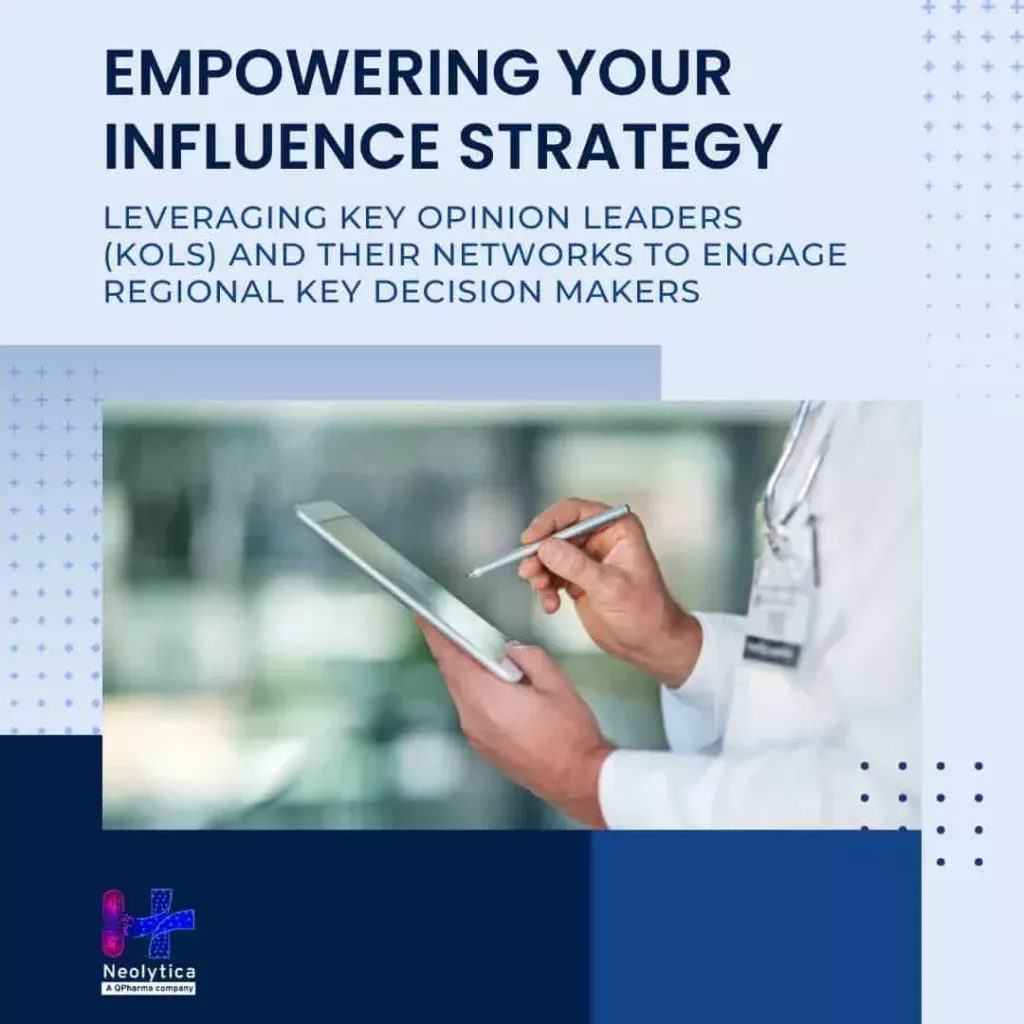In the fiercely competitive pharmaceutical industry, an effective influence strategy is paramount for achieving market access and commercial success. Regional key decision makers, such as formulary committees, reimbursement authorities, and healthcare administrators, hold significant sway over access to therapies. In this comprehensive blog post, we will explore the vital role that Key Opinion Leaders (KOLs) and their networks play in engaging regional key decision makers. By leveraging the expertise and connections of KOLs, pharmaceutical companies can enhance their influence strategy and drive positive outcomes.
Understanding Key Opinion Leaders (KOLs):
KOLs are distinguished experts who possess extensive knowledge and influence within specific therapeutic areas. They are respected for their contributions to research, clinical practice, and thought leadership. KOLs include academic researchers, renowned clinicians, patient advocates, and influential healthcare professionals. Their expertise and networks position them as trusted advisors to regional key decision makers, making them valuable assets in the influence strategy.
Identifying Relevant Key Decision Makers:
Identifying and segmenting key decision makers within target regions is essential for effective engagement. Pharmaceutical companies employ various methods to identify decision makers, including analyzing organizational structures, researching committee members, and monitoring public statements. By leveraging KOL insights, companies gain a deeper understanding of the most influential decision makers in specific regions. This knowledge enables strategic prioritization and targeted engagement efforts.
Building Relationships with Key Opinion Leaders (KOLs):
Establishing strong relationships with KOLs who have established connections to regional decision makers is a critical aspect of the influence strategy. By collaborating with trusted KOLs, pharmaceutical companies can access decision makers and gain valuable insights into their perspectives and priorities. Building mutual trust and fostering long-term partnerships with KOLs facilitates effective communication and creates opportunities for collaboration that benefit both parties.
One notable example of successful KOL engagement is the partnership between a pharmaceutical company and a renowned oncologist who had established relationships with key decision makers in cancer centers. Through joint initiatives, such as educational programs and research collaborations, the pharmaceutical company was able to engage decision makers effectively, resulting in formulary inclusion and improved access to their innovative cancer therapy.
Leveraging KOL Networks for Engagement:
KOL networks provide a powerful mechanism for reaching and influencing regional key decision makers. KOLs, as trusted opinion leaders, have extensive networks that include fellow physicians, researchers, policymakers, and patient advocacy groups. Pharmaceutical companies can harness the influence of KOLs by seeking their recommendations, co-creating content, and leveraging their endorsements. By leveraging KOL networks, companies can expand their reach, increase engagement with decision makers, and amplify their influence.
A prime example of leveraging KOL networks is the collaboration between a pharmaceutical company and a group of influential KOLs specializing in rare diseases. By engaging these KOLs in advocacy efforts and utilizing their networks, the company successfully raised awareness about the disease, influenced reimbursement policies, and improved patient access to their breakthrough therapy.
Developing Targeted Messaging and Content:
Tailoring messaging and content to resonate with regional key decision makers is crucial for effective communication. Collaboration with KOLs who have a deep understanding of decision makers’ interests and needs is invaluable in crafting compelling content. By involving KOLs in the development of educational materials, scientific presentations, and clinical data summaries, companies ensure that their messages align with decision makers’ priorities. This tailored approach enhances the chances of capturing decision makers’ attention and influencing their decisions.
Measuring and Evaluating Impact
Measuring the impact of KOL engagement on influencing regional decision makers is essential for assessing the effectiveness of the influence strategy. Key metrics and indicators, such as formulary inclusion rates, adoption rates, and feedback from decision makers, provide quantitative and qualitative insights. Tracking and analyzing data enable companies to evaluate the impact of their efforts, make data-driven decisions, and continuously optimize their influence strategy for maximum effectiveness.
Overcoming Challenges and Best Practices
Engaging with regional key decision makers presents challenges, including limited access, varying stakeholder priorities, and evolving dynamics. Pharmaceutical companies can overcome these challenges by adopting best practices. These include building strong relationships with KOLs, understanding decision makers’ perspectives, adapting strategies to suit regional dynamics, and actively listening to decision makers’ feedback. Maintaining long-term relationships, open communication channels, and staying abreast of the evolving needs of decision makers are key to sustained success.
Conclusion
Leveraging the expertise and networks of KOLs is a game-changer in engaging regional key decision makers. Pharmaceutical companies that effectively incorporate KOL insights and collaborations into their influence strategies can navigate the complexities of regional decision-making processes and position themselves for success. By identifying relevant decision makers, building strong relationships with influential KOLs, leveraging their networks, developing targeted messaging, and continuously measuring impact, companies can empower their influence strategy and drive regional market access and commercial success. The key takeaways and actionable insights provided in this article serve as a guide for optimizing influence strategies and embracing the transformative power of KOL engagement in regional markets.

